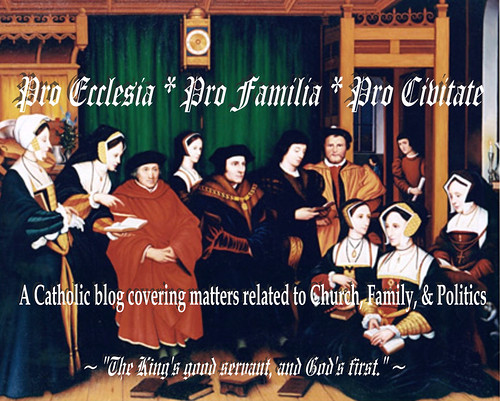Carhart, Casey, and the Supreme Court's Catholics
Catholic legal scholar Professor Rick Garnett writes that for a judge to credit the legislature's conclusion that human fetuses are moral subjects whose lives have value is not to impose "religious" beliefs:
Fifteen years ago, Justice Anthony Kennedy co-authored an opinion in Planned Parenthood v. Casey which proclaimed that “liberty finds no refuge in a jurisprudence of doubt” and re-affirmed a woman’s “right to terminate her pregnancy in its early stages.” On April 18, however, Justice Kennedy wrote the opinion for a five-Justice majority in Gonzales v. Carhart which rejected a “broad, facial attack” on the federal Partial-Birth Abortion Ban Act of 2003. What happened?
***
... the attacks on the majority’s ruling are coming fast and furious. According to New York Times, this decision was “atrocious” and “comes at a real cost to the court’s credibility, its integrity and the rule of law.” In some quarters, the Court’s decision not to nullify a bipartisan and popular act of Congress is seen – oddly enough – as an instance of the very “judicial activism” that conservatives purport to oppose. Still others detect in the ruling – in the words of one blogger – a “chill wind blowing from Rome.”
The five Justices in the majority, remember, are Roman Catholics.
There were no Catholic Justices on the Court until 1836, when Roger Taney succeeded John Marshall. And it would be more than another half-century – fifty-eight years – until the elevation of the second, Edward White. Looking back, the fact that only one of our first 54 Justices was Catholic should come as no surprise. From the Puritans to the Framers and beyond, anti-“popery” was long thick the cultural air of America. Well into the twentieth century, it was regularly charged and widely believed that there is something un-American about Catholic clergy, teachings, and adherents. And so, it is not surprising that, over the years, politicians and commentators alike have demanded assurances that Catholic judicial nominees would not be “Catholic” justices. President Roosevelt, for example, was promised that Frank Murphy would “not let religion stand in his way,” and Murphy himself made it clear that his faith and his judicial vocation were kept “in air-tight compartments.”
These familiar questions were raised again – if more artfully and cautiously – after the nominations of Justice Alito and Chief Justice Roberts. Indeed, the rarely reticent Christopher Hitchens challenged his colleagues in the press to “quit tiptoeing around John Roberts’ faith.” After all, he observed, the Catholic Church is a “foreign state” and “claims the right to legislate on morals[.]” Hitchens was hardly alone in being alarmed by the prospect of a majority-Catholic Court. Many worried that the Catholic Justices might be tempted to substitute their own personal religious convictions, or the moral teachings of their Church, for the Constitution’s requirements, particularly in cases involving divisive and difficult “social issues.”
According to one of the legal academy’s most distinguished constitutional law scholars, Carhart suggests that these worries were well founded. In a widely noted blog post, my colleague Professor Geoffrey Stone characterized and criticized the majority in Carhart as “faith-based justices” who “failed to respect the fundamental difference between religious belief and morality. To be sure,” he wrote, “this can be an elusive distinction, but in a society that values the separation of church and state, it is fundamental.”
The distinction is, indeed, “elusive.” And, in any event, the charge is misplaced. It is true that the majority included “moral concerns” – like the public interest in promoting “respect for life” – among the “legitimate government interests” that could justify the federal ban. It is not clear, though, why we should regard these concerns, or the view that human fetuses are moral subjects whose lives have value, as any more “religious”, and therefore suspect, than our nation’s fundamental commitment to the view that all human beings are moral equals, regardless of race, and should be treated as such in law. For a judge to identify such concerns as a permissible basis for legislating – given the fact that, in the Court’s view, the law did not impose an “undue burden” on the abortion right – is not to attack church-state separation or to substitute revelation for the will of We the People.
It is, of course, hardly a secret that a Catholic justice is taught by his or her Church, and should believe, that abortion is a grave moral evil. However, all judges – Catholic or not – come to the bench with views, commitments, and experiences that shape their decision-making and reasoning. We can, and should, ask of every judge that she work conscientiously in every case to identify not her own preferred or “faith-based” outcome but the answer that is given by the relevant legal texts, rules, and precedents. As it happens, the Catholic understanding of vocation, and of justice under law, extends to Catholic judges the same invitation.
[More]
Previous Pro Ecclesia posts on this subject:
And Finally ... The New York Times Weighs In
More Supreme Anti-Catholic Bigotry
Church Defenders Take On Anti-Catholic Cartoonist
And the Philadelphia Enquirer [sic] Joins In (With an Anti-Catholic Cartoon)
In Case You Missed It ...
How Long ...
Labels: Anti-Catholicism, Constitutional Jurisprudence, Law, Pro-Life, Schumer Doctrine, Supreme Court



0 Comments:
Post a Comment
<< Home